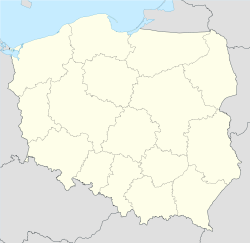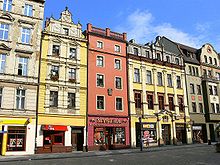- Świdnica
-
For the village of the same name, see Świdnica, Lubusz Voivodeship.
Świdnica Old town 
Coat of armsCoordinates: 50°51′N 16°29′E / 50.85°N 16.483°ECoordinates: 50°51′N 16°29′E / 50.85°N 16.483°E Country  Poland
PolandVoivodeship Lower Silesian County Świdnica County Gmina Świdnica (urban gmina) Established City rights 1267 Government – President Wojciech Murdzek Area – Total 22 km2 (8.5 sq mi) Elevation 250 m (820 ft) Population (2006) – Total 60,354 – Density 2,743.4/km2 (7,105.3/sq mi) Time zone CET (UTC+1) – Summer (DST) CEST (UTC+2) Postal code 58-100 to 58-106 Area code(s) +48 74 Car plates DSW Website http://www.um.swidnica.pl Świdnica [ɕfidˈnit͡sa] (German: Schweidnitz; Czech: Svídnice) is a city in south-western Poland in the region of Silesia. It has a population of 60,317 according to 2006 figures. It lies in Lower Silesian Voivodeship, being the seventh largest town in that voivodeship. From 1975–98 it was in the former Wałbrzych Voivodeship. It is now the seat of Świdnica County, and also of the smaller district of Gmina Świdnica (although it is not part of the territory of the latter, as the town forms a separate urban gmina).
Contents
History
About 990 the territory on which Świdnica was later founded became part of Poland. Świdnica became a town in 1250, although no founding document has survived that would confirm this fact. In the beginning, the town belonged to the Duchy of Wrocław (Breslau) and experienced two important privileges conducive to its development.[citation needed] By 1290, Świdnica had city walls and six gates, crafts and trade were blossoming, and it had become the capital of the Duchy of Świdnica. City was in 1291-1392 capital of Duchy of Świdnica.
At the end of the 14th century the city was under rule of the Kingdom of Bohemia, and a long period of growth began. The last Piast duke was Bolko II of Świdnica, and after his death in 1368 land was held by his wife until 1392; after her death they were incorporated into the lands of Bohemia by Wenceslaus, King of the Romans. In 1493, the town is recorded by Hartmann Schedel in his Nuremberg Chronicle as Schwednitz[1]
In 1471, there were 47 trade guilds in operation, nearly 300 homes had the rights to brew beer, and large cattle and hops fairs were organized. The beer was distributed in many European cities, including Breslau, Prague, Heidelberg, Kraków, and Pisa. The beer was offered in pubs.
In 1526, all of Silesia, including Schweidnitz, came under the rule of the Habsburg Monarchy. The city of Schweidnitz was in the surrounding Duchy of Schweidnitz. The Thirty Years' War (1618–48) ravaged the Duchy. The town was annexed by the Kingdom of Prussia during the First Silesian War early in the Seven Years' War. It was subsequently turned into a fortress by Frederick II of Prussia's army.
Schweidnitz was captured again by Austria in late 1762, but remained Prussian after the end of the Seven Years' War. Subsequently Schweidnitz became part of the Prussian-led German Empire in 1871 during the unification of Germany and stayed within Germany until the end of World War II.
The town was placed under Polish administration according to the post-war Potsdam Conference in 1945 and renamed Świdnica. The German population who had not fled during the war were subsequently expelled and forced westward into post-war Germany and replaced with Poles, many of whom had been expelled themselves from Polish areas annexed by the Soviet Union.
Sights
The Gothic Church of Ss. Stanislav and Vaclav from the 14th century has the highest tower in Silesia, standing 103 meters tall. The Evangelical Church of Peace, a UNESCO Heritage site, was built from 1656–57. The 16th century town hall has been renovated numerous times and combines Gothic, Renaissance, and Baroque architectural elements. The Baroque Church of St. Joseph and the Church of St. Christopher are from the same era. One remaining element of the former defensive works is the Chapel of St. Barbara. Other sights include the old town and the Stary rynek square.
Notable residents
- Thomas Stoltzer (ca. 1480-1526), composer
- Hieronymus Treutler (1565–1607), doctor of law, professor of rhetoric, Imperial Councillor
- Maria Cunitz (1604–64), astronomer, daughter of Schweidnitz Dr. Heinrich Kunitz
- Benjamin Schmolk (1672–1737), composer, poet
- Johann Christoph Glaubitz (c. 1700 - 1767 in Vilnius) architect
- Johann Gottlieb Janitsch (1708–63), composer
- Paul von Kulmiz (1836–1895), industrialist, politician
- Georg Beer (1865–1946), theologian, teacher Deutschen Christen
- Emil Krebs (1867–1930), sinologist
- Ferdinand Friedensburg (1886–1972), politician
- Michael Graf von Matuschka (1888–1944), resistance fighter
- Manfred von Richthofen (1892–1918), World War I ace known as "The Red Baron"
- Peter Adolf Thiessen (1899–1990), physical chemist
- Heinz Starke (1911–2001), politician, Bundesfinanzminister 1961-1962
- Georg Gärtner (born 1920), known as "Hitler´s last Soldier in America"
- Armin Müller (1928–2005) artist, author
- Gunther Gebel-Williams (1934–2001), animal trainer
- Hans-Jürgen Otto (* 1935), forrester
- Manfred Kanther (born 1939), politician
- Henning Eichberg (born 1942), cultural sociologist
- Marek Michalak (born 1971), Chancellor of the International Capital of the Order of Smile
- Katarzyna Glinka (born 1977), actress
- Bartosz Huzarski (* 1980), byciclist
Education
Świdnica is home to a College of Data Communications Technology (Wyższa Szkoła Technologii Teleinformatycznych).
In 2003 Świdnica hosted a session of the Warsaw-based International Chapter of the Order of Smile, when a Child Friendship Centre was established. Świdnica was officially titled the "Capital of Children's Dreams".
International relations
Twin towns — Sister cities
Świdnica is twinned with:
 Ivano-Frankivsk, Ukraine[2]
Ivano-Frankivsk, Ukraine[2] Maldegem, Belgium
Maldegem, Belgium Police nad Metují, Czech Republic
Police nad Metují, Czech Republic Trutnov, Czech Republic
Trutnov, Czech Republic Švenčionys district municipality, Lithuania
Švenčionys district municipality, Lithuania
Notes
References
- ^ See Die Schedelsche Weltchronik on German Wikisource.
- ^ "Офіційний сайт міста Івано-Франківська" (in Ukrainian). mvk.if.ua. http://www.mvk.if.ua/news/4114/. Retrieved 7 March 2010.
External links
- Silesia Map of 1600s with Town of Schweidnitz in Duchy of Schweidnitz
- Website of the municipality of Świdnica
 Media related to Świdnica at Wikimedia Commons
Media related to Świdnica at Wikimedia Commons Chisholm, Hugh, ed (1911). "Schweidnitz". Encyclopædia Britannica (11th ed.). Cambridge University Press.
Chisholm, Hugh, ed (1911). "Schweidnitz". Encyclopædia Britannica (11th ed.). Cambridge University Press.
Urban gminas Świdnica (seat) • Świebodzice
Urban-rural gminas Rural gminas Villages Bojanice • Boleścin • Burkatów • Bystrzyca Dolna • Bystrzyca Górna • Gogołów • Grodziszcze • Jagodnik • Jakubów • Komorów • Krzczonów • Krzyżowa • Lubachów • Lutomia Dolna • Lutomia Górna • Lutomia Mała • Makowice • Miłochów • Modliszów • Mokrzeszów • Niegoszów • Opoczka • Panków • Pogorzała • Pszenno • Słotwina • Stachowice • Stachowiczki • Sulisławice • Wieruszów • Wilków • Wiśniowa • Witoszów Dolny • Witoszów Górny • Zawiszów • Złoty Las
Seat (not part of the gmina) ŚwidnicaCategories:- Świdnica
- Cities and towns in Lower Silesian Voivodeship
- Świdnica County
- Former principalities
Wikimedia Foundation. 2010.







